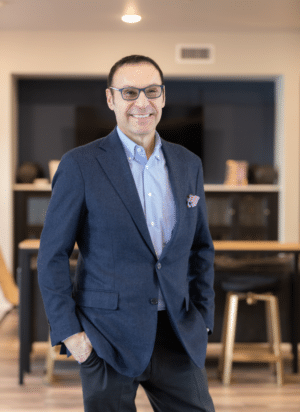Michael Belfonti
CEO, Belfonti Cos.
Industry experience: 40 years
Michael Belfonti made his first real estate deal as a junior at Boston University, lining up investors to acquire a roominghouse in nearby Brookline, Massachusetts. Rather than working his way up through the ranks at a bigger real estate company, Belfonti chose to build his own firm from scratch. Relocating to his native Connecticut in the 1980s, Belfonti concentrated on apartment-to-condominium conversions before expanding into acquisitions and commercial and multifamily development. Today the Hamden-based firm is redeveloping the former Ames retail chain headquarters in Rocky Hill as a mixed-use development including 213 apartments, along with commercial and retail space. After the recent cancellation of a planned life science development in Branford, Belfonti Cos. is looking for alternative commercial uses for the high-profile development site along Interstate 95.
Q: Having worked through previous economic downturns including the financial crisis of 2008, how do you compare the current real estate environment?
A: Recessions take form in many different shapes. What happened in the early 1990s was banks just lent too much on inflated values. I don’t think that has happened this time around. Banks have been much more cautious. But when a person goes from a variable rate of 4 percent to 7 percent, there’s a whipsaw effect and you can’t help but lose in terms of your positive leverage. Costs have gone up commensurate with rents, along with property taxes in Connecticut and insurance, so that has exacerbated the expense line. In Cromwell, we just completed The Landon of Cromwell [apartment development] and refinanced for a long period of time. In Rocky Hill, our construction lender is Liberty Bank and we caught the market there right as well. We got a construction loan before they went up too high. Today, it’s a different story because it’s very difficult to find a project that has positive leverage. The cost of money is higher than the return on cost. The cost of construction is the second bullet. It’s been another challenge over the last 24 to 36 months: materials and labor have gone up around 25 percent. That’s significant.
Q: Is the Branford HealthTech Park project moving forward?
A: We’re speaking to a national developer right now who wants to develop a hotel and conference center. For the biotech project, Ryan Cos. has pulled out of the joint venture. So we’re talking to a hotel and conference center, and we have other parcels within the 100 acres [site] that are suitable for industrial such as last-mile distribution and manufacturers. I don’t see residential on that site.
Q: Are you pausing development projects until the macroeconomic climate changes?
A: We still have some Connecticut deals in the pipeline that we hope to be announcing soon. We just got approval for 180 units in North Port, Florida and will start construction in nine months, and we’re looking at other Florida opportunities as well on the East Coast from Miami to Palm Beach. The barriers to entry in Florida are much lower. It’s easier to get approved, but you have to be careful about absorption. A bunch of apartments could pop up around you very quickly and depress rents. In Connecticut, the barriers of entry are higher, but it takes you longer to get approved.
Q: Have you taken advantage of the Section 8-30g affordable housing law to get projects approved in communities with restrictive zoning preventing multifamily development?
A: Section 8-30g was designed when it was so difficult to get apartments approved, and municipalities were not cooperative with developers. It was sort of a way for the state to trump the municipality and get apartments built. For us, it’s too burdensome in terms of the affordable requirements. That’s not to say I wouldn’t do it, but we have passed on a few of those opportunities.







